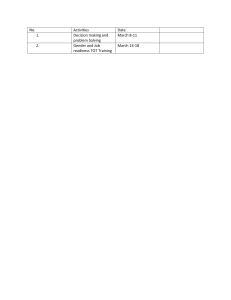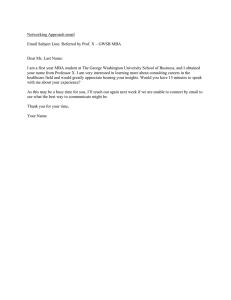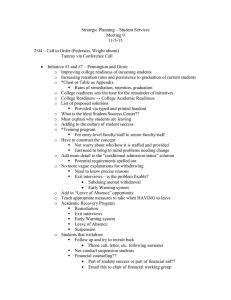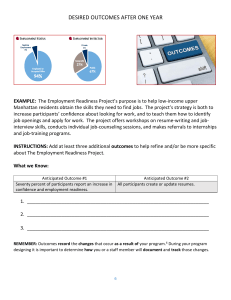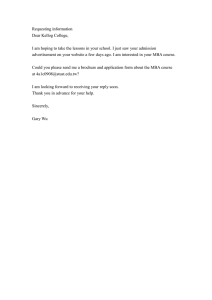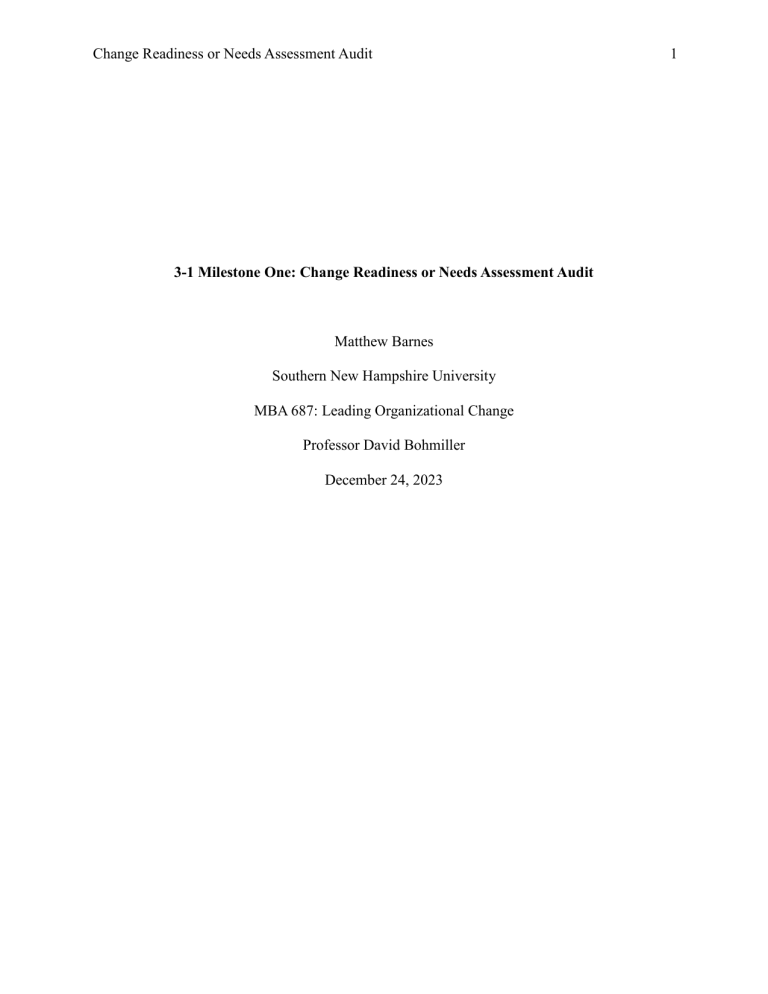
Change Readiness or Needs Assessment Audit 3-1 Milestone One: Change Readiness or Needs Assessment Audit Matthew Barnes Southern New Hampshire University MBA 687: Leading Organizational Change Professor David Bohmiller December 24, 2023 1 Change Readiness or Needs Assessment Audit 2 Create Visuals During the change readiness and needs assessment audit for the U.S. branch, we noticed many issues that need to be addressed to enact some change. Throughout this report, I will list my findings and will assist in the adoption of the change plans. Below are some charts drawn up based off the Employee Engagement Surveys conducted. The first bar graph shows the number of employees who received a merit increase or a promotion in the past two years. This chart shows that the only employees who received any merit increase are those that were promoted, and only 7.5% of the employees received a promotion. The second column graph shows the employees’ views on how the company feels or talks about diversity. 41% of the employees feel that the company tries to promote a work environment free from discrimination and harassment. Only 18% feel the environment at the company is supportive of the expression of different opinions, styles, and perceptions. And lastly, 34% are satisfied with the company’s efforts to support and encourage difference. (MBA 687 Employee Engagement Surveys, n.d.) EMPLOYEES WHO RECEIEVE MERIT OR PROMOTION IN 2 YEARS No Answer No Yes 0,00% 10,00% 20,00% 30,00% 40,00% 50,00% 60,00% 70,00% 80,00% 90,00% 100,00% Company on Diversity 41% 34% 18% FREE FROM DISCRIMINATION AND HARRASSMENT SUPPORTIVE OF OTHER OPINIONS, STYLES, AND PERCEOPTION SUPPORT AND ENCOURAGE DIFFERENCES Change Readiness or Needs Assessment Audit 3 Next, we can see pie charts based off the company vision, values, and mission. 41% have a clear understanding of the organization’s direction, whereas only 26% are familiar with the company’s vision and values and feel like the organization is changing for the better. Now we can look at the difference between middle managers and senior management. The last pie chart shows how the employees view each, 36% feel senior managers are open, honest, and transparent, while 70% of the middle managers are viewed this way. This shows that middle managers are closer to the employees and that they are trusted. (MBA 687 Employee Engagement Surveys, n.d.) Compnay Vision, Values, & Mission Management Who is Open, Honest, and Transparent Familiar 26 26 Clear Understanding 36 For the Better 36 70 Senior Leaders Middle Managers Employees’ Confidence Based off the above pie chart and the explanation behind it, this shows that the employees do not have high confidence in their senior management to be open, honest, and transparent. There is an urgency for the change initiative within the U.S sectors based off the employee engagement survey and the leaders’ self-evaluations. We already discussed the employee engagement survey, but the leaders’ self-evaluations show that all departments are not familiar with change management skills or cross-cultural awareness. Middle managers need to be able to buy-in to the adoption mindset, “Adoption is the process of planning for, and then taking Change Readiness or Needs Assessment Audit 4 on, a change.” (Gilbert, 2009) Many organizations can get the planning down, but taking out is a different story. In the example by Gilbert 2009, the organization planned with “a cross-functional team instead visualized both the implementation and the adoption of the new system, as separate and distinct sets of activities.” (Gilbert, 2009) This way, the middle managers can act as a bridge between the senior leaders within the organization. Next, the middle managers must create ownership of the proposed change initiative. This can be done by letting the middle managers take the initiative and letting them think about what the change means to them personally. “mid-level leaders work within their networks, reiterating the change articulated by the executives and asking the people within their influence the questions that will help them arrive at their insights and draw their own conclusions about what's needed for them to adopt the change.” (Gilbert, 2009) Ensuring that there is a cross-functional team will allow for proper power distribution, allowing all to feel included and have input. Having a leadership style that is not a traditional hierarchical structure will ensure the process is seamless. Opportunities to Increase Change Readiness/Trust There are many reasons why some employees may be more accepting to change while others might be more reluctant. One reason being that when the employees were hired, they were provided a job description of their duties, these changes may change their agreed upon duties and cause more work, while others may view the change as what benefits may come of it. With increased production and turnouts, there could be merit increases or other benefits. After reviewing the exit interview statistics and comments, many of the reasons for leaving the organization were the relationship with management and lack of career opportunities accounting for 60%. Many of the comments point to upward dissent which is “People who attempt to use influence on Change Readiness or Needs Assessment Audit 5 decisionmakers during the change management process. Some may seek to influence a leader through a third party hoping the leader hears the concerns, but not directly from the source.” (Forms of Resistance Grid, n.d.) Many of the exit interview comments stated that they brough ideas to their middle managers (3rd party) but the senior leadership took no action or a long delay in the process. The second form of resistance that can be deemed a cause for concern on the exit interviews is Ambivalence “People who vocalize a move toward change and also vocalize a struggle against change. They may experiencing both positive and negative feelings about different aspects of the change at the same time.” (Forms of Resistance Grid, n.d.) Many of the comments stated they liked working in an international workplace and had positive views of the organization and what it could be, but also had negative views between the balance between both sides of the organization and the hierarchical/top-down management styles of leadership. Cultural Considerations Looking at Hofstede’s model below, we can determine that 6 cultural dimension model, we can gain further insight on what factors should be considered when working in an intercultural workplace. After creating a profile for the country, we can gather useful information about if they are individualistic or collectivistic, masculine, or feminine, etc. Using this information, we can better interpret what senior leadership acts the way they do. For example, if the power distance is high, it is expected and accepted to happen. The information and chart below are a great example to see the differences between countries and how they may work differently than other countries. Individualistic or collectivistic are another reason that could explain one employee’s negative comment on their exit interview. “When I suggested ideas for improvement, it took the task force forever to get new ideas implemented, and it was difficult to speed up this process. I don’t see why we have to go through the Singapore team's management Change Readiness or Needs Assessment Audit 6 when we can collaborate at a team level?” (Exit Interviews, n.d.) If the Singapore cultural dimensions show the country is more individualistic, then they may not want to collaborate at a team level and use their power distance to let the senior management handle their suggestions for improvement. Source: Lewis, L., Kouzes, J. M., & Posner, B. Z. (2019). Leading Organization Change (2nd ed.). (p. 145) Wiley Solutions. December 8, 2023, https://eds-s-ebscohostcom.ezproxy.snhu.edu/eds/ebookviewer/ebook?sid=cc5ddbcf-80e2-4b07-a8a68f7115066a5f%40redis&ppid=pp_39&vid=0&format=EB Change Readiness or Needs Assessment Audit 7 References Gilbert, J. (2009). The sandwich generation: the emerging role of middle managers in organizational change. Paper presented at PMI® Global Congress 2009—North America, Orlando, FL. Newtown Square, PA: Project Management Institute. Lewis, L., Kouzes, J. M., & Posner, B. Z. (2019). Leading Organization Change (2nd ed.). Wiley Solutions. December 8, 2023, https://read.wiley.com/books/9781119832591/page/145/section/top-of-page MBA 687 Employee Engagement Surveys. SNHU. (n.d.) MBA 687 Exit Interviews. SNHU. (n.d.) MBA 687 Forms of Resistance Grid. SNHU. (n.d.) MBA 687 Leaders Self Evaluations. SNHU. (n.d.) MBA 687 US Branch Overview. SNHU. (n.d.)
